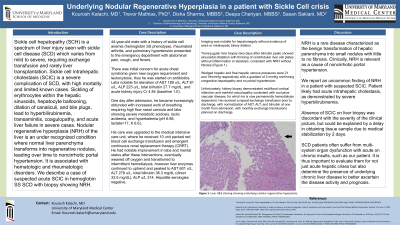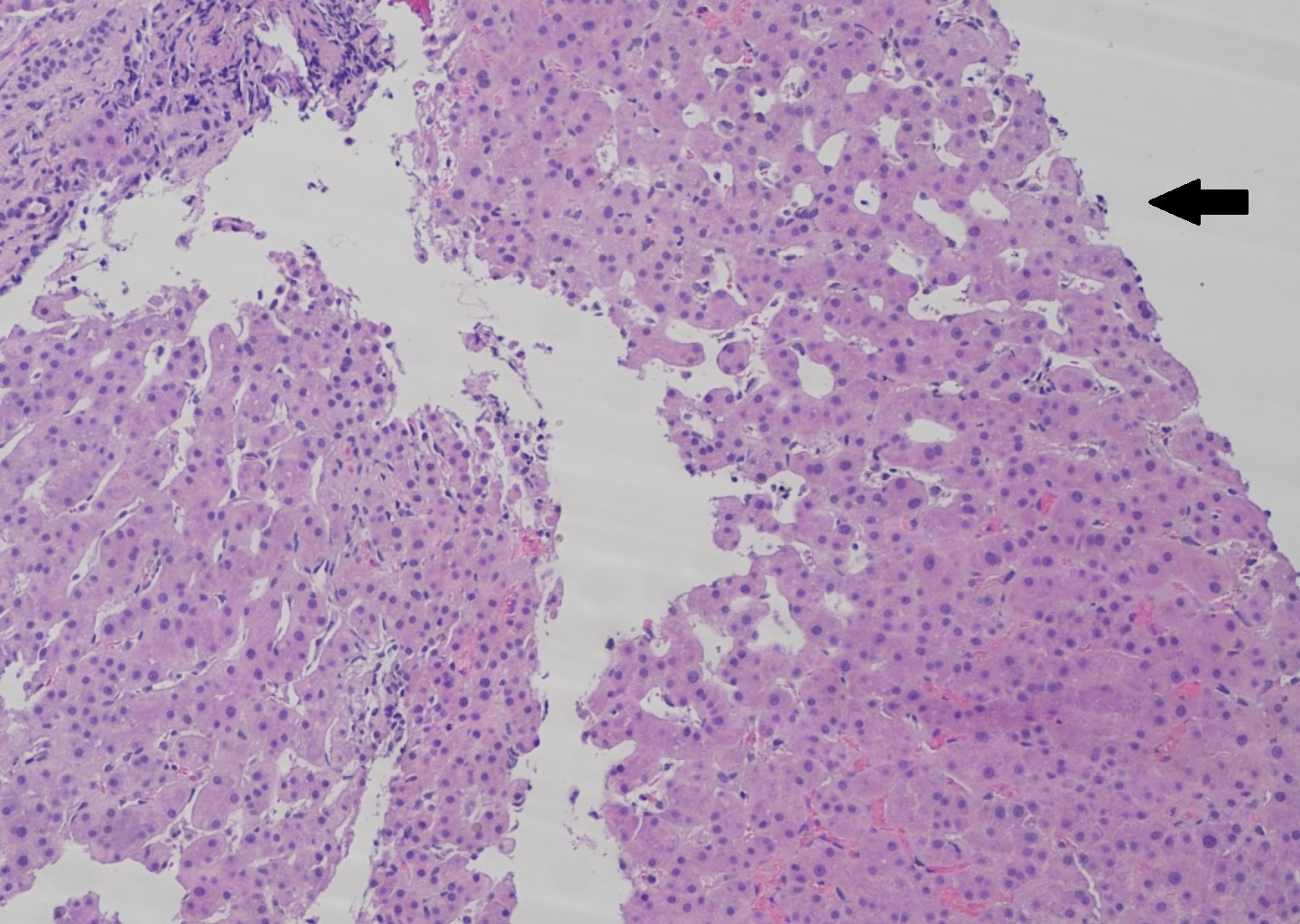Sunday Poster Session
Category: Liver
P1137 - Underlying Nodular Regenerative Hyperplasia in a Patient With Sickle Cell Crisis
Sunday, October 22, 2023
3:30 PM - 7:00 PM PT
Location: Exhibit Hall

Has Audio
- KK
Kourosh Kalachi, MD
University of Maryland Medical Center
Rockville, MD
Presenting Author(s)
Kourosh Kalachi, MD1, Disha Sharma, MBBS2, Trevor J. Mathias, PhD3, Deepa Cheriyan, MBBS4, Sasan Sakiani, MD4
1University of Maryland Medical Center, Rockville, MD; 2University of Maryland, Baltimore, MD; 3University of Maryland School of Medicine, Baltimore, MD; 4University of Maryland Medical Center, Baltimore, MD
Introduction: Sickle cell hepatopathy (SCH) is a spectrum of liver injury seen with sickle cell disease (SCD) that varies from mild to severe, requiring exchange transfusion and rarely liver transplantation. Sickle cell intrahepatic cholestasis (SCIC) is a severe complication of SCD, with high mortality and limited known cases. Sickling of erythrocytes within the hepatic sinusoids, hepatocyte ballooning, dilation of canaliculi, and bile plugs, lead to hyperbilirubinemia, transaminitis, coagulopathy, and acute liver failure in severe cases. Nodular regenerative hyperplasia (NRH) of the liver is an under recognized condition where normal liver parenchyma transforms into regenerative nodules, leading over time to noncirrhotic portal hypertension. It is associated with hematologic and rheumatologic disorders. We describe a case of suspected acute SCIC in hemoglobin SS SCD with biopsy showing NRH.
Case Description/Methods: A 44 year old male history of SCD, pulmonary hypertension presented with back pain, cough, and fevers with concerns for vaso occlusive crises (VOC) including acute chest syndrome. He developed multi-organ failure secondary to VOC: acute hypoxic respiratory syndrome, shock, and renal failure requiring renal replacement therapy. Notably, his liver enzymes during admission peaked to AST 601 u/L, ALT 278 u/L, total bilirubin 36.3 mg/dL, ALP 314 u/L. Viral serologies negative. Imaging showed hepatomegaly, and no evidence of extra and intrahepatic biliary dilation. Trans-jugular liver biopsy (two days after bilirubin peak) was consistent with NRH without fibrosis (Figure 1) with wedged hepatic and free hepatic venous pressures 21 and 18mmHg respectively with a gradient of 3 mmHg confirming congestive hepatopathy and no portal hypertension. Course improved post exchange transfusion, with down trending of liver enzymes and bilirubin.
Discussion: We report an uncommon finding of NRH in a patient with suspected SCIC. Patient likely had acute intrahepatic cholestasis, indicated by severe hyperbilirubinemia. Absence of SCIC on liver biopsy was discordant with the severity of the clinical picture, but could be explained by delay in obtaining tissue sample due to medical stabilization by 2 days. SCD patients often suffer from multi-system organ dysfunction with acute on chronic insults, such as our patient. Thus, it is important to evaluate them for not just acute hepatic crises but also determine the presence of underlying chronic liver disease to better ascertain the disease activity and prognosis.

Disclosures:
Kourosh Kalachi, MD1, Disha Sharma, MBBS2, Trevor J. Mathias, PhD3, Deepa Cheriyan, MBBS4, Sasan Sakiani, MD4. P1137 - Underlying Nodular Regenerative Hyperplasia in a Patient With Sickle Cell Crisis, ACG 2023 Annual Scientific Meeting Abstracts. Vancouver, BC, Canada: American College of Gastroenterology.
1University of Maryland Medical Center, Rockville, MD; 2University of Maryland, Baltimore, MD; 3University of Maryland School of Medicine, Baltimore, MD; 4University of Maryland Medical Center, Baltimore, MD
Introduction: Sickle cell hepatopathy (SCH) is a spectrum of liver injury seen with sickle cell disease (SCD) that varies from mild to severe, requiring exchange transfusion and rarely liver transplantation. Sickle cell intrahepatic cholestasis (SCIC) is a severe complication of SCD, with high mortality and limited known cases. Sickling of erythrocytes within the hepatic sinusoids, hepatocyte ballooning, dilation of canaliculi, and bile plugs, lead to hyperbilirubinemia, transaminitis, coagulopathy, and acute liver failure in severe cases. Nodular regenerative hyperplasia (NRH) of the liver is an under recognized condition where normal liver parenchyma transforms into regenerative nodules, leading over time to noncirrhotic portal hypertension. It is associated with hematologic and rheumatologic disorders. We describe a case of suspected acute SCIC in hemoglobin SS SCD with biopsy showing NRH.
Case Description/Methods: A 44 year old male history of SCD, pulmonary hypertension presented with back pain, cough, and fevers with concerns for vaso occlusive crises (VOC) including acute chest syndrome. He developed multi-organ failure secondary to VOC: acute hypoxic respiratory syndrome, shock, and renal failure requiring renal replacement therapy. Notably, his liver enzymes during admission peaked to AST 601 u/L, ALT 278 u/L, total bilirubin 36.3 mg/dL, ALP 314 u/L. Viral serologies negative. Imaging showed hepatomegaly, and no evidence of extra and intrahepatic biliary dilation. Trans-jugular liver biopsy (two days after bilirubin peak) was consistent with NRH without fibrosis (Figure 1) with wedged hepatic and free hepatic venous pressures 21 and 18mmHg respectively with a gradient of 3 mmHg confirming congestive hepatopathy and no portal hypertension. Course improved post exchange transfusion, with down trending of liver enzymes and bilirubin.
Discussion: We report an uncommon finding of NRH in a patient with suspected SCIC. Patient likely had acute intrahepatic cholestasis, indicated by severe hyperbilirubinemia. Absence of SCIC on liver biopsy was discordant with the severity of the clinical picture, but could be explained by delay in obtaining tissue sample due to medical stabilization by 2 days. SCD patients often suffer from multi-system organ dysfunction with acute on chronic insults, such as our patient. Thus, it is important to evaluate them for not just acute hepatic crises but also determine the presence of underlying chronic liver disease to better ascertain the disease activity and prognosis.

Figure: Liver biopsy on H&E stain, 100x magnification. Marked sinusoidal dilatation (black arrow) can be seen with thinning of centrilobular liver cell plates, representative of nodular regenerative hyperplasia without significant inflammation, fibrosis, or steatosis.
Disclosures:
Kourosh Kalachi indicated no relevant financial relationships.
Disha Sharma indicated no relevant financial relationships.
Trevor Mathias indicated no relevant financial relationships.
Deepa Cheriyan indicated no relevant financial relationships.
Sasan Sakiani indicated no relevant financial relationships.
Kourosh Kalachi, MD1, Disha Sharma, MBBS2, Trevor J. Mathias, PhD3, Deepa Cheriyan, MBBS4, Sasan Sakiani, MD4. P1137 - Underlying Nodular Regenerative Hyperplasia in a Patient With Sickle Cell Crisis, ACG 2023 Annual Scientific Meeting Abstracts. Vancouver, BC, Canada: American College of Gastroenterology.
